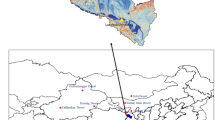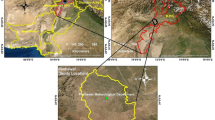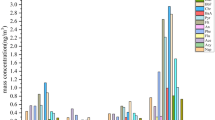Abstract
Receptor models have been widely used for identifying and quantifying source-specific contributions from mixtures of air pollutants. Nonetheless, our knowledge is still limited on how various components of air pollution are vertically distributed and the sources of such pollutants. In this study, we collected 135 samples of PM2.5 (particles with aerodynamic diameter less than or equal to 2.5 µm) from building balconies at three altitudes in the metropolis of Taipei (Taiwan) and analyzed the samples for elements and polycyclic aromatic hydrocarbons that could be used to identify the sources of those pollutants. We used positive matrix factorization (PMF) to identify seven likely sources, including combustion, sulfur-rich aerosol, fresh traffic, industry/Cr-rich, oil combustion/vehicle, dust, and traffic. Although PM2.5 mass differed significantly between low-level and mid-level sites, the largest contributor to PM2.5 mass (sulfur-rich aerosol, 35.2%) showed nonsignificant variation in the vertical distribution. In contrast, oil combustion/vehicle, which exhibited significant difference between mid-level sites and the other two altitudes, might be a determinant in the vertical variation of PM2.5. We also observed negative trends with sampling height for combustion and traffic emissions.
This is a preview of subscription content, access via your institution
Access options
Subscribe to this journal
Receive 6 print issues and online access
$259.00 per year
only $43.17 per issue
Buy this article
- Purchase on Springer Link
- Instant access to full article PDF
Prices may be subject to local taxes which are calculated during checkout




Similar content being viewed by others
References
WHO. Global health risks: mortality and burden of disease attributable to selected major risks. Geneva: World Health Organization; 2009. Report no.: 9241563877.
IARC. IARC monographs on the evaluation of carcinogenic risks to humans: vol. 109, Outdoor Air Pollution. Lyon, France: International Agency for Research on Cancer; 2016.
Belis CA, Karagulian F, Larsen BR, Hopke PK. Critical review and meta-analysis of ambient particulate matter source apportionment using receptor models in Europe. Atmos Environ. 2013;69:94–108.
Hopke PK. Review of receptor modeling methods for source apportionment. J Air Waste Manag Assoc. 2016;66:237–59.
Reff A, Eberly SI, Bhave PV. Receptor modeling of ambient particulate matter data using positive matrix factorization: review of existing methods. J Air Waste Manag Assoc. 2007;57:146–54.
Viana M, Kuhlbusch TAJ, Querol X, Alastuey A, Harrison RM, Hopke PK, et al. Source apportionment of particulate matter in Europe: a review of methods and results. J Aerosol Sci. 2008;39:827–49.
Jang E, Alam MS, Harrison RM. Source apportionment of polycyclic aromatic hydrocarbons in urban air using positive matrix factorization and spatial distribution analysis. Atmos Environ. 2013;79:271–85.
Li Y-C, Yu JZ, Ho SSH, Yuan Z, Lau AKH, Huang X-F. Chemical characteristics of PM2.5 and organic aerosol source analysis during cold front episodes in Hong Kong, China. Atmos Res. 2012;118:41–51.
Teixeira EC, Mattiuzi CD, Agudelo-Castaeda DM, Garcia KD, Wiegand F. Polycyclic aromatic hydrocarbons study in atmospheric fine and coarse particles using diagnostic ratios and receptor model in urban/industrial region. Environ Monit Assess. 2013;185:9587–602.
Eeftens M, Tsai MY, Ampe C, Anwander B, Beelen R, Bellander T, et al. Spatial variation of PM2.5, PM10, PM2.5 absorbance and PMcoarse concentrations between and within 20 European study areas and the relationship with NO2—results of the ESCAPE project. Atmos Environ. 2012;62:303–17.
Achilleos S, Wolfson JM, Ferguson ST, Kang C-M, Hadjimitsis DG, Hadjicharalambous M, et al. Spatial variability of fine and coarse particle composition and sources in Cyprus. Atmos Res. 2016;169(Part A):255–70.
Kim E, Hopke PK, Pinto JP, Wilson WE. Spatial variability of fine particle mass, components, and source contributions during the regional air pollution study in St. Louis. Environ Sci Technol. 2005;39:4172–9.
Mooibroek D, Schaap M, Weijers EP, Hoogerbrugge R. Source apportionment and spatial variability of PM2.5 using measurements at five sites in the Netherlands. Atmos Environ. 2011;45:4180–91.
Wang JZ, Cao JJ, Dong ZB, Guinot B, Gao ML, Huang RJ, et al. Seasonal variation, spatial distribution and source apportionment for polycyclic aromatic hydrocarbons (PAHs) at nineteen communities in Xi’an, China: the effects of suburban scattered emissions in winter. Environ Pollut. 2017;231:1330–43.
De Nicola F, Murena F, Costagliola MA, Alfani A, Baldantoni D, Prati MV, et al. A multi-approach monitoring of particulate matter, metals and PAHs in an urban street canyon. Environ Sci Pollut Res. 2013;20:4969–79.
Pongpiachan S. Diurnal variation, vertical distribution and source apportionment of carcinogenic polycyclic aromatic hydrocarbons (PAHs) in Chiang-Mai, Thailand. Asian Pac J Cancer Prev. 2013;14:1851–63.
Kalaiarasan M, Balasubramanian R, Cheong KWD, Tham KW. Particulate-bound polycyclic aromatic hydrocarbons in naturally ventilated multi-storey residential buildings of Singapore: vertical distribution and potential health risks. Build Environ. 2009;44:418–25.
Sasaki K, Sakamoto K. Vertical differences in the composition of PM10 and PM2.5 in the urban atmosphere of Osaka, Japan. Atmos Environ. 2005;39:7240–50.
Wu CD, Lung SCC. Applying GIS and fine-resolution digital terrain models to assess three-dimensional population distribution under traffic impacts. J Expo Sci Environ Epidemiol. 2012;22:126–34.
Wang J, Zhou M, Liu BS, Wu JH, Peng X, Zhang YF, et al. Characterization and source apportionment of size-segregated atmospheric particulate matter collected at ground level and from the urban canopy in Tianjin. Environ Pollut. 2016;219:982–92.
Jung KH, Bernabe K, Moors K, Yan B, Chillrud SN, Whyatt R, et al. Effects of floor level and building type on residential levels of outdoor and indoor polycyclic aromatic hydrocarbons, blackcarbon, and particulate matter in New York City. Atmosphere. 2011;2:96–109.
Tao S, Wang Y, Wu S, Liu S, Dou H, Liu Y, et al. Vertical distribution of polycyclic aromatic hydrocarbons in atmospheric boundary layer of Beijing in winter. Atmos Environ. 2007;41:9594–602.
Kalaiarasan M, Balasubramanian R, Cheong KWD, Tham KW. Traffic-generated airborne particles in naturally ventilated multi-storey residential buildings of Singapore: vertical distribution and potential health risks. Build Environ. 2009;44:1493–1500.
Quang TN, He C, Morawska L, Knibbs LD, Falk M. Vertical particle concentration profiles around urban office buildings. Atmos Chem Phys. 2012;12:5017–30.
Du W, Zhao J, Wang YY, Zhang YJ, Wang QQ, Xu WQ, et al. Simultaneous measurements of particle number size distributions at ground level and 260m on a meteorological tower in urban Beijing, China. Atmos Chem Phys. 2017;17:6797–811.
Azimi P, Zhao H, Fazli T, Zhao D, Faramarzi A, Leung L, et al. Pilot study of the vertical variations in outdoor pollutant concentrations and environmental conditions along the height of a tall building. Build Environ. 2018;138:124–34.
Xiao ZM, Wu JH, Han SQ, Zhang YF, Xu H, Zhang XY, et al. Vertical characteristics and source identification of PM10 in Tianjin. J Environ Sci. 2012;24:112–5.
Wu H, Zhang YF, Han SQ, Wu JH, Bi XH, Shi GL, et al. Vertical characteristics of PM2.5 during the heating season in Tianjin, China. Sci Total Environ. 2015;523:152–60.
Moeinaddini M, Esmaili Sari A, Riyahi bakhtiari A, Chan AY, Taghavi SM, Hawker D, et al. Source apportionment of PAHs and n-alkanes in respirable particles in Tehran, Iran by wind sector and vertical profile. Environ Sci Pollut Res Int. 2014;21:7757–72.
Ho C-C, Chan C-C, Cho C-W, Lin H-I, Lee J-H, Wu C-F. Land use regression modeling with vertical distribution measurements for fine particulate matter and elements in an urban area. Atmos Environ. 2015;104:256–63.
Norris G, Duvall R, Brown S, Bai S. EPA positive matrix factorization (PMF) 5.0 fundamentals and user guide. U.S. Environmental Protection Agency, Washington, DC, EPA/600/R-14/108 (NTIS PB2015-105147), 2014.
Liao H-T, Chou CCK, Huang S-H, Lu C-J, Chen C-C, Hopke PK, et al. Source apportionment of PM2.5 size distribution and composition data from multiple stationary sites using a mobile platform. Atmos Res. 2017;190:21–8.
Xie M, Coons TL, Hemann JG, Dutton SJ, Milford JB, Peel JL, et al. Intra-urban spatial variability and uncertainty assessment of PM2.5 sources based on carbonaceous species. Atmos Environ. 2012;60:305–15.
RTI. Standard operating procedure for the X-ray fluorescence analysis of particulate matter deposits on teflon filters. Research Triangle Park, North Carolina: Environmental and Industrial Measurements Division; 2009.
Van Drooge BL, Nikolova I, Ballesta PP. Thermal desorption gas chromatography-mass spectrometry as an enhanced method for the quantification of polycyclic aromatic hydrocarbons from ambient air particulate matter. J Chromatogr A. 2009;1216:4030–9.
Ho SS, Yu JZ, Chow JC, Zielinska B, Watson JG, Sit EH, et al. Evaluation of an in-injection port thermal desorption-gas chromatography/mass spectrometry method for analysis of non-polar organic compounds in ambient aerosol samples. J Chromatogr A. 2008;1200:217–27.
Brown SG, Eberly S, Paatero P, Norris GA. Methods for estimating uncertainty in PMF solutions: examples with ambient air and water quality data and guidance on reporting PMF results. Sci Total Environ. 2015;518:626–35.
Kuo CP, Liao HT, Chou CC, Wu CF. Source apportionment of particulate matter and selected volatile organic compounds with multiple time resolution data. Sci Total Environ. 2014;472:880–7.
Miller SL, Anderson MJ, Daly EP, Milford JB. Source apportionment of exposures to volatile organic compounds. I. Evaluation of receptor models using simulated exposure data. Atmos Environ. 2002;36:3629–41.
Polissar AV, Hopke PK, Paatero P. Atmospheric aerosol over Alaska—2. Elemental composition and sources. J Geophys Res Atmos. 1998;103:19045–57.
Liao H-T, Chou CCK, Chow JC, Watson JG, Hopke PK, Wu C-F. Source and risk apportionment of selected VOCs and PM2.5 species using partially constrained receptor models with multiple time resolution data. Environ Pollut. 2015;205:121–30.
Paatero P, Hopke PK. Discarding or downweighting high-noise variables in factor analytic models. Anal Chim Acta. 2003;490:277–89.
Wu C-F, Larson TV, Wu S-Y, Williamson J, Westberg HH, Liu LJS. Source apportionment of PM2.5 and selected hazardous air pollutants in Seattle. Sci Total Environ. 2007;386:42–52.
Anttila P, Paatero P, Tapper U, Järvinen O. Source identification of bulk wet deposition in Finland by positive matrix factorization. Atmos Environ. 1995;29:1705–18.
Lee E, Chan CK, Paatero P. Application of positive matrix factorization in source apportionment of particulate pollutants in Hong Kong. Atmos Environ. 1999;33:3201–12.
Tian YZ, Shi GL, Han SQ, Zhang YF, Feng YC, Liu GR, et al. Vertical characteristics of levels and potential sources of water-soluble ions in PM10 in a Chinese megacity. Sci Total Environ. 2013;447:1–9.
Shi GL, Liu GR, Tian YZ, Zhou XY, Peng X, Feng YC. Chemical characteristic and toxicity assessment of particle associated PAHs for the short-term anthropogenic activity event: during the Chinese New Year’s Festival in 2013. Sci Total Environ. 2014;482:8–14.
Gao B, Wang XM, Zhao XY, Ding X, Fu XX, Zhang YL, et al. Source apportionment of atmospheric PAHs and their toxicity using PMF: impact of gas/particle partitioning. Atmos Environ. 2015;103:114–20.
Li CT, Lin YC, Lee WJ, Tsai PJ. Emission of polycyclic aromatic hydrocarbons and their carcinogenic potencies from cooking sources to the urban atmosphere. Environ Health Perspect. 2003;111:483–7.
Lung SCC, Hu SC. Generation rates and emission factors of particulate matter and particle-bound polycyclic aromatic hydrocarbons of incense sticks. Chemosphere. 2003;50:673–9.
Liao HT, Yau YC, Huang CS, Chen N, Chow JC, Watson JG, et al. Source apportionment of urban air pollutants using constrained receptor models with a priori profile information. Environ Pollut. 2017;227:323–33.
Marcazzan GM, Vaccaro S, Valli G, Vecchi R. Characterisation of PM10 and PM2.5 particulate matter in the ambient air of Milan (Italy). Atmos Environ. 2001;35:4639–50.
Hsu SC, Liu SC, Huang YT, Chou CCK, Lung SCC, Liu TH, et al. Long-range southeastward transport of Asian biosmoke pollution: signature detected by aerosol potassium in Northern Taiwan. J Geophys Res-Atmos. 2009;114:17.
Hsu SC, Liu SC, Jeng WL, Lin FJ, Huang YT, Lung SCC, et al. Variations of Cd/Pb and Zn/Pb ratios in Taipei aerosols reflecting long-range transport or local pollution emissions. Sci Total Environ. 2005;347:111–21.
Janhall S, Molnar P, Hallquist M. Vertical distribution of air pollutants at the Gustavii Cathedral in Goteborg, Sweden. Atmos Environ. 2003;37:209–17.
Larsen RK, Baker JE. Source apportionment of polycyclic aromatic hydrocarbons in the urban atmosphere: a comparison of three methods. Environ Sci Technol. 2003;37:1873–81.
Park SS, Kim YJ. Source contributions to fine particulate matter in an urban atmosphere. Chemosphere. 2005;59:217–26.
Jain S, Sharma SK, Choudhary N, Masiwal R, Saxena M, Sharma A, et al. Chemical characteristics and source apportionment of PM2.5 using PCA/APCS, UNMIX, and PMF at an urban site of Delhi, India. Environ Sci Pollut R. 2017;24:14637–56.
Viana M, Querol X, Alastuey A, Gil JI, Menéndez M. Identification of PM sources by principal component analysis (PCA) coupled with wind direction data. Chemosphere. 2006;65:2411–8.
Han JS, Moon KJ, Lee SJ, Kim YJ, Ryu SY, Cliff SS, et al. Size-resolved source apportionment of ambient particles by positive matrix factorization at Gosan background site in East Asia. Atmos Chem Phys. 2006;6:211–23.
Pakkanen TA, Kerminen VM, Loukkola K, Hillamo RE, Aarnio P, Koskentalo T, et al. Size distributions of mass and chemical components in street-level and rooftop PM1 particles in Helsinki. Atmos Environ. 2003;37:1673–90.
Sun YL, Zhuang GS, Ying W, Han LH, Guo JH, Mo D, et al. The air-borne particulate pollution in Beijing—concentration, composition, distribution and sources. Atmos Environ. 2004;38:5991–6004.
Swietlicki E, Krejci R. Source characterisation of the Central European atmospheric aerosol using multivariate statistical methods. Nucl Instrum Methods Phys Res Sect B. 1996;109:519–25.
Hsu CY, Chiang HC, Chen MJ, Chuang CY, Tsen CM, Fang GC, et al. Ambient PM2.5 in the residential area near industrial complexes: spatiotemporal variation, source apportionment, and health impact. Sci Total Environ. 2017;590:204–14.
Gugamsetty B, Wei H, Liu CN, Awasthi A, Hsu SC, Tsai CJ, et al. Source characterization and apportionment of PM10, PM2.5 and PM0.1 by using positive matrix factorization. Aerosol Air Qual Res. 2012;12:476–91.
Karnae S, John K. Source apportionment of fine particulate matter measured in an industrialized coastal urban area of South Texas. Atmos Environ. 2011;45:3769–76.
Kim E, Hopke PK, Edgerton ES. Source identification of Atlanta aerosol by positive matrix factorization. J Air Waste Manag Assoc. 2003;53:731–9.
Wimolwattanapun W, Hopke PK, Pongkiatkul P. Source apportionment and potential source locations of PM2.5 and PM2.5–10 at residential sites in metropolitan Bangkok. Atmos Pollut Res. 2011;2:172–81.
Gramsch E, Ormeno I, Palma G, Cereceda-Balic F, Oyola P. Use of the light absorption coefficient to monitor elemental carbon and PM2.5—example of Santiago de Chile. J Air Waste Manag Assoc. 2004;54:799–808.
Cadle SH, Groblicki PJ. An evaluation of methods for the determination of organic and elemental carbon in particulate samples. In: Wolff GT, Klimisch RL (eds). Particulate Carbon. Springer: Boston, MA, 1982. pp 89–109.
Cyrys J, Heinrich J, Hoek G, Meliefste K, Lewne M, Gehring U, et al. Comparison between different traffic-related particle indicators: elemental. carbon (EC), PM2.5 mass, and absorbance. J Expo Anal Environ Epidemiol. 2003;13:134–43.
Jin XC, Xiao CJ, Li J, Huang DH, Yuan GJ, Yao YG, et al. Source apportionment of PM2.5in Beijing using positive matrix factorization. J Radioanal Nucl Chem. 2016;307:2147–54.
Qi L, Chen MD, Ge XL, Zhang YF, Guo BF. Seasonal variations and sources of 17 aerosol metal elements in suburban Nanjing, China. Atmosphere. 2016;7:21.
Callen MS, Iturmendi A, Lopez JM. Source apportionment of atmospheric PM2.5-bound polycyclic aromatic hydrocarbons by a PMF receptor model. Assessment of potential risk for human health. Environ Pollut. 2014;195:167–77.
Wang JZ, Ho SSH, Ma SX, Cao JJ, Dai WT, Liu SX, et al. Characterization of PM2.5 in Guangzhou, China: uses of organic markers for supporting source apportionment. Sci Total Environ. 2016;550:961–71.
Mousavi A, Sowlat MH, Sioutas C. Diurnal and seasonal trends and source apportionment of redox-active metals in Los Angeles using a novel online metal monitor and Positive Matrix Factorization (PMF). Atmos Environ. 2018;174:15–24.
Acknowledgements
This study was supported in part by research grants from the Ministry of Science and Technology of Taiwan (MOST103‐2221‐E‐002‐008‐MY3, MOST105‐2811‐E‐002‐038, and MOST 106‐2811‐E‐002‐080), the National Taiwan University (105R4000), and the Featured Areas Research Center Program within the framework of the Higher Education Sprout Project by the Ministry of Education of Taiwan (NTU-107L9003).
Author information
Authors and Affiliations
Corresponding author
Ethics declarations
Conflict of interest
The authors declare that they have no conflict of interest.
Additional information
Publisher’s note: Springer Nature remains neutral with regard to jurisdictional claims in published maps and institutional affiliations.
Supplementary information
Rights and permissions
About this article
Cite this article
Liao, HT., Chang, JC., Tsai, TT. et al. Vertical distribution of source apportioned PM2.5 using particulate-bound elements and polycyclic aromatic hydrocarbons in an urban area. J Expo Sci Environ Epidemiol 30, 659–669 (2020). https://doi.org/10.1038/s41370-019-0153-2
Received:
Revised:
Accepted:
Published:
Issue Date:
DOI: https://doi.org/10.1038/s41370-019-0153-2
Keywords
This article is cited by
-
Vertical variation of source-apportioned PM2.5 and selected volatile organic compounds near an elevated expressway in an urban area
Environmental Science and Pollution Research (2024)



